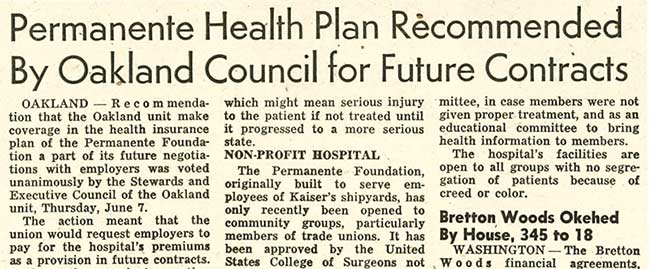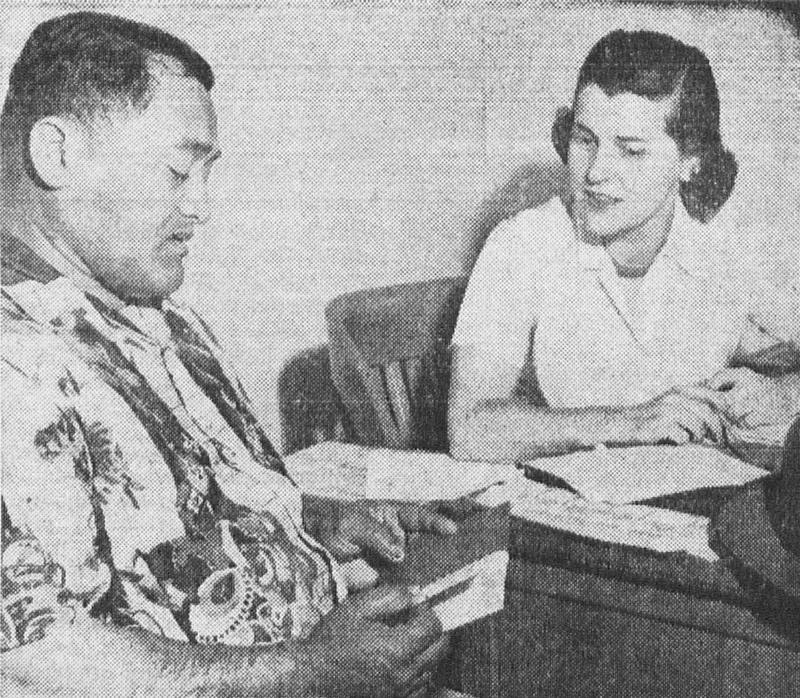Kaiser Permanente and Group Health Cooperative: Working together since 1950
The formation of Kaiser Permanente Washington comes from longstanding collaboration, commitment, and dedication to delivering affordable health care to the community.
"Permanente pediatric clinic at 515 Market St, San Francisco - nurse giving Patricia Nisby, daughter of ILWU Local 10 member Wiley Nisby, a shot." ILWU Dispatcher, October 13, 1950.
It’s official. Kaiser Permanente has acquired Group Health Cooperative, making Kaiser Permanente Washington our newest region, the first in over 30 years.
Although this merger is brand new, the 2 organizations began collaborating more than 65 years ago. Group Health Cooperative of Puget Sound (they dropped the “of Puget Sound” in 1995), like Kaiser Permanente, was always a mission-driven organization that approached health care in a very different way from traditional fee-for-service medicine.
In fact, few know that our common roots go as far back as 1950, just three years after Group Health Cooperative’s founding.
The relationship began in 1949 when the International Longshore and Warehouse Union [ILWU] approached Kaiser Permanente (then called the Permanente Health Plan) about taking on their membership. Initially it was the 20,000 members in the San Francisco Bay Area, with the understanding that it would soon be all of their members on the rest of the coast, from Seattle down to San Diego. Permanente and the ILWU had been in discussion since 1945. Among the many advantages raised was "The hospital's facilities are open to all groups with no segregation of patients because of creed or color." Imagine that.

In a 1974 interview, Kaiser Permanente founding physician Sidney Garfield, MD, reflected on this earliest relation between Kaiser Permanente and Group Health Cooperative:
"We were rather anxious to get the membership of course, but we couldn't spread our service that far. We did have a service up in Portland, so that was fine. We got the doctors up there to accept those members, they wanted to do it too. In Los Angeles we had no service. We had it in Fontana, which is quite a distance away, maybe 70 miles from San Pedro. In San Diego we had no service.
"[In the Northwest] what we did was arrange with… a prepaid plan up in Seattle, Group Health Association [Cooperative] I think they call it, so we talked them into taking on Longshoremen up there and there was a prepaid plan down in San Diego, a small one, and we talked them into taking on the Longshoremen, and we tackled the Los Angeles, San Francisco, Bay Area and the San Pedro area."

The Pacific Maritime Association began making a 3 cents per man hour contribution to the Welfare Fund on December 26, 1949.
Hospital plans go into effect as of February 1, 1950. Permanente Foundation's Health plan will cover the San Francisco, Los Angeles and Portland – Vancouver areas. There is already a setup in Portland similar to the one in the San Francisco Bay Area. Permanente will open a clinic in Wilmington, Calif., immediately upon the ratification of the Welfare Plan by all locals.
In Seattle, Wash., the Group Health Cooperative of Puget Sound made the offer of medical care on the same basis and at the same price as Permanente.
By year’s end, 90 percent of eligible ILWU member had signed up for the plan. It was voluntary; the Permanente Foundation Health Plan was committed to offering “dual choice” to groups, so that no member would feel resentful at having something forced on them.
Group Health Cooperative communicator Pat Bailey adds this point:
"This contract for 2,200 ILWU enrollees for Group Health came at a time when the Cooperative was cash-starved. But as already noted, with the new enrollees came pent-up health needs. Before long, the waiting list for hernia operations numbered as many as 50."

Anne Waybur of the ILWU Research Department interviewing longshoreman to find out what he thinks of the Permanente Health Plan coverage and service
It's hard to overstate the deep impact that this contractually-negotiated benefit made in the lives of the ILWU members.
When the plan began, there was a big rush for treatment of such illnesses as hernias and hemorrhoids, conditions the men had suffered with and lived with for many years. They hadn't been able to pay for medical care on their own. A 1951 brochure produced by the ILWU about the Multiphasic testing examination noted that “…many of our members have not been to the doctor until they practically collapsed on the job.”
A March 10, 1950, article in The Dispatcher put it this way:
“The Welfare Plan is the greatest thing since the hiring hall." That's the opinion of D.N. (Lefty) Vaughn, Local 13 longshoreman, hospitalized here under Permanente. Vaughn told Local 13 visitors last week that if it wasn't for the Welfare Plan he would have had to sell his home in order to pay for the major operation he's getting for nothing through the Plan."
An editorial 3 weeks later further explained:
"Life can be beautiful if you're healthy is the way the ad men put it. There's no doubt they've got a point, though it's oversimplified. Health is no fringe issue, not when you are required to make a choice between an operation which will allow you to go on working and living, and the home you must sell to pay for that operation. Longshoremen no longer have to make such choices. More than one home has been saved since the medical coverage section of the Welfare Plan became effective two months ago."
Kaiser Permanente and Group Health Cooperative partnered to help working American families get good health care since 1950.
Thanks to Robin Walker, ILWU archivist, for help with this article.